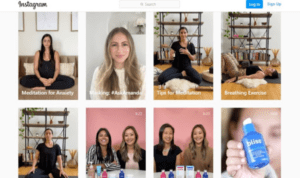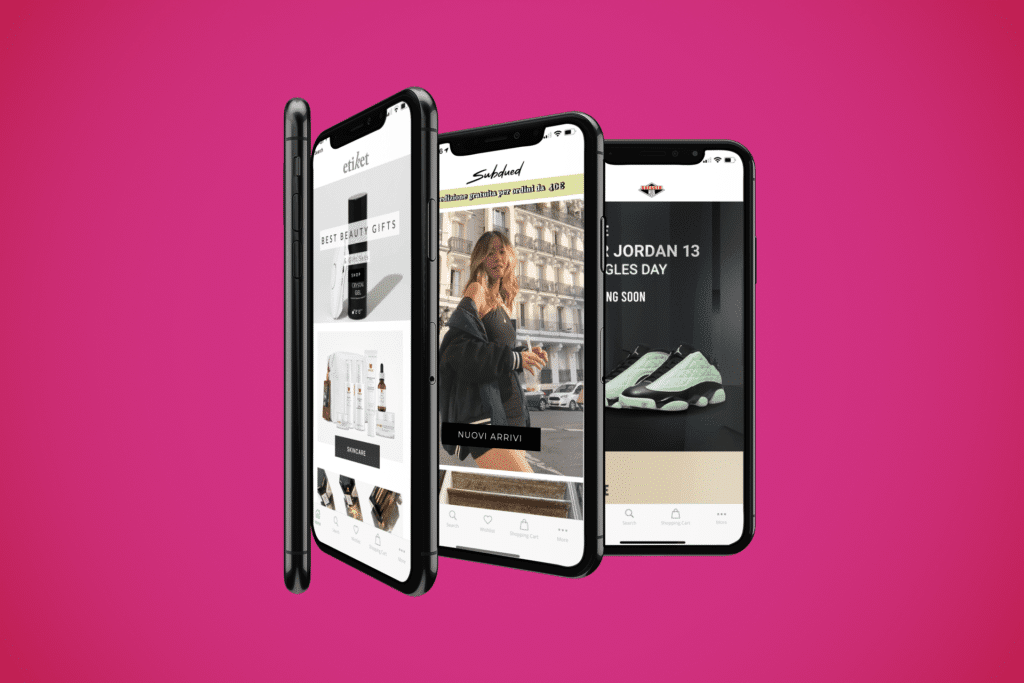Scary, or exciting? 2022 is getting closer, and we’re going full speed ahead at it. It’s time for all brands to stop hiding behind excuses about not being a big enough player, or being busy, or not busy enough. Apps, mobile marketing—being where your consumers are—it’s become the standard. And it’s doable. Scratch that. It’s necessary.
We’re excited to bring the latest mobile marketing trends into the new year. No trials or tricks, but real tactics that drive real results.
In this article, you’ll find all the know-how on getting the base right, and the building blocks to make your mobile marketing strategy really effective.
What you should know about mobile marketing in 2022
How often do you catch yourself buying something quickly via your smartphone? That one Instagram ad that’s been lurking and has finally made you curious enough about a product to hit the ‘shop now’ button. And wow, wasn’t that fast? Before you know it, you’re going on with your day again.
Do you still save products on your phone for later, when you’re behind your desktop? Or do you just want to get it over with instantly?
Mobile is no longer a fun side project
What every marketer, business owner and entrepreneur should know about marketing in 2022, is that it’ll be mostly mobile. It’ll go beyond being mobile-friendly or even optimized for smaller screens. Real marketing heroes will create and optimize their apps, websites, emails, and whatnot specifically for mobile.
It’s no longer the extra in the background. We’ve grown attached to our mobile phones, and countless consumers are still waiting for their favorite brands to catch up and start serving them properly there.
The way we shop has changed forever. So, the way you attract, convert and engage, should do too.
Our phone is with us everywhere
There’s an opportunity for marketing around the clock—and jumping in at just the right moment. That’s because 91% of us keep our mobile devices within arm’s reach 24 hours a day. The average American spends 5.4 hours on their phone every day.
This has naturally led to a shift in where e-commerce web traffic comes from. For retailers, 65% comes straight from our mobile devices. For fashion stores specifically, that number is 70%.
Those aren’t rookie numbers, and it deserves its own name and fame: mobile commerce (or m-commerce) has seen an average increase of 33.8% each year since 2016, the biggest growth rate of all channels, according to Statista.
Mobile commerce is now the new heartbeat in the customer journey.
But it’s not just B2C that has switched to shopping and decision-making on the go. The Boston Consulting Group found that about 70% of B2B queries today are made on smartphones.
Consider this: that is more than half of your entire business, possibly revenue. Can you really afford not to invest in that?
The challenges and opportunities our mobile behavior bring
While all of this is great to tell at parties and motivating enough to ‘go mobile’, you’ll need a detailed plan of attack. One that identifies the weak spots of your target audience, and plays with the strengths of your business.
One thing your team will have to realize is that mobile shoppers and desktop shoppers behave very differently—even if they’re essentially the same person.
- People are impatient. The whole reason we’re buying from our phones is that we don’t want to wait, and certainly don’t want to wait until we are near our laptop.
- What this means for you: speed it up. Make sure loading times are minimized, checkout is easy and straightforward and people can find what they need instantly.
- People judge quicker. Having everything at the tip of our fingers means that we’ll go for the best option available. There’s no forgiving and very little second chances. According to Google, when a mobile experience is not optimized, 53% of shoppers will never return. It’s the harsh reality.
- What this means for you: optimize, check and then double check. Make sure the experience in your app or mobile website is flawless.
- People are more impulsive. We tend to research a bit longer behind our desktop. With our smartphone, we just buy. 70% of mobile searches lead to action within an hour. People using desktop on the other hand, can toss and turn for a month.
- What this means for you: make shopping instantly possible. Make your socials shoppable, always link to products and put up or cross-sell products in plain sight.
Knowing all this, how do you get started or expand your mobile marketing strategy to boost your ecommerce business? We’ll walk you through all the elements.
7 Elements for successful mobile marketing
An effective mobile marketing strategy requires an omnichannel approach. It’s not just having an app, or just having a mobile-optimized website.
Keep in mind that mobile is a two-way street. Ask yourself this:
- What mobile tools can I use to optimize how I reach out to my audience?
- What mobile tools does my audience like to use when reaching out to me?
Go holistic and implement all these elements into your strategy to succeed on all fronts.
1. Mobile-friendly websites
Mobile-friendly websites aren’t just websites made to fit a small screen. The best brands out there have made mobile versions of their websites completely separate from their desktop version.
Because the same rules simply don’t apply, like we pointed out earlier. On a desktop version, you might want to give more info to help them do research. On your mobile version, you want to highlight the Buy Now button. Here are some other rules to abide:
- Content fits on the screen. Don’t make people zoom in or out.
- Scrolling makes sense. Does anyone really scroll horizontally on a website?
- Clicking links is easy: redirecting and opening new tabs shouldn’t cause chaos
- Everything is easy to find
2. Mobile apps.
Think making an app is a waste of time? Think again.
Especially if you want to build loyalty and retention, mobile apps are the way to go. You can give users a way smoother experience than any browser could, and it feels more exclusive.
And creating an app is really not just for big tech-y companies. Look at Honest Greens, for example. With only three restaurants in Barcelona, they were able to create an app that their audience loves.
They don’t miss out on customers who get decision fatigue in apps like UberEats where they are just one of many options. Instead, they created one beautiful place with really good pictures of their food, a built-in loyalty program and a sense of exclusivity.
Why wouldn’t a website be enough? Well, research has shown that conversion rates are three times higher in apps than on a website. Over 67 percent of sales happen in-app. Those are numbers you don’t want to miss out on.
3. Text and push message marketing
Text messages are still a thing. SMS, WhatsApp, and push messages are a great way to directly reach out to your audience, but use them wisely. Nobody wants to receive pointless push messages without actual value. Use them sparsely and only for your best offers and discounts. Fashion retailer MANGO, for instance, used SMS to send their members exclusive discount codes that worked online and in store. Now that’s a message we’d like to receive.

4. Mobile-friendly ads and matching landing pages
If you’re planning to launch a new campaign and mobile users are in your audience, make sure to create ads and landing pages that look great on smartphones.
Search and display ads need to be optimized to make sure you’re getting your full message across. Nothing is more annoying than a sentence cut off at the.
Mix and match with display ads and search ads, depending on your goals. Plus, you can use ads for mobile specific campaigns
On top of that, mobile ads are also great for retargeting purposes. This is a real conversion booster and really flourishes when you use an omnichannel e-commerce strategy. Make sure to put your best copywriters and designers on it, however—you don’t want the message to become repetitive and annoying.
5. Voice search optimization.
It’s becoming more and more normalized to talk not just through, but also with your smartphone.
Siri or Google hear the strangest questions, and voice search is becoming increasingly important for ecommerce businesses.
With our hands free, we are now able to ask and even order almost anything we want. Make sure your business is ready for that.
Keyword research for voice optimization is different from regular written SEO, so don’t just copy-paste. It’s all about finding long-tail phrases and identifying which words are more commonly used in speech, as opposed to in writing.
6. Social media and video
Social media apps are already optimized for mobile—so why not make use of the technology that Instagram and Facebook have developed for you? 38% of consumers would be most open to purchasing clothing via social media in the next 30 days. That could be from your brand, if only you make it possible.
We’ve talked about having the right buttons and landing pages in place, but if you really want to give it a boost, use video.
Videos are often what give us that last push. 85% of millennials say they’ve bought a product after seeing a video of it.
Explainer videos, reviews, unboxing—or even whole runway videos to show off a dress: they’re a new way to engage with your audience and show your product from all angles. Something they’ll definitely appreciate.

Image Source: Instagram
Take Bliss for example. This beauty brand Bliss doubled down on their video content marketing strategy on Instagram. The brand’s IGTV feed is packed with truly helpful videos that their target audience is sure to love—and share.
7. Email
Last but not least—good old email. How many of us check our email before we even get to work? Or even before we get out of bed. Research by Litmus shows that 57% of email is opened on mobile platforms. Is your newsletter or email not optimized for that? Then 69% of mobile users will delete your email instantly.
A responsive design, to-the-point copy (phones aren’t Kindles) and a clear CTA is what will keep your emails relevant and loved by your audience.
‘’So, where do I start my app marketing strategy?’’
I’m glad you asked. Although there’s no one-size-fits-all approach to this, depending on your business and current strategy, there are some steps you should definitely not miss. We’ll walk you through them.
Step 1. Analyze your mobile results.
Let’s start with the basics: how many people are currently trying to reach your mobile channels, and how are they performing? Look at the percentage of traffic coming in, the conversion rates of these people, and where they drop out. You’ll find this under:
Reports>Audience>Mobile>Overview.
Step 2. Dive into the mobile profile
Now you know how many people are looking you up from their mobile, it’s time to get to know them better. You can again use Google Analytics to find out demographics, like age, locations, and interests.
Knowing who your buyer is, will help you to choose the right social or display platforms to target your mobile ads.
Step 3. Improve the user experience.
Whether your mobile audience is 25 percent of all your visitors or 75, they all deserve attention and care. This means investing in the user experience. Start by investigating current user experiences.
What pages are apparently not working, due to long loading times and huge dropout rates? What does your content look like? Don’t hesitate to reach out to an expert or survey your audience to get their opinion.
Before you launch a campaign to attract new app users or anything else focused on mobile, make sure they are welcomed in a neatly organized place—otherwise you’ll lose them again.
Step 4. Launch your mobile app.
Ready for launch? Ask yourself this question, repeatedly.
Test your app thoroughly and make sure it’s clear what objectives it serves, both for your business and for your customers.
A better mobile site might only improve your conversion rate from 2 to 2.7. But a mobile app, when done right, will triple your conversion rate. It’s all about experience. Imagine your conversion rate going from 2% to 6%.
Another cool thing about e-commerce apps is that by simply adding a smart app banner, any mobile visitor on your site will see a banner to download your app. And get this: at least one third of customers do so. Then, that higher conversion rate becomes even more valuable, doesn’t it? Plus, eventually, the average order value increases by 23%.
Luckily for businesses of all sizes, using a SaaS app builder has made it fairly affordable and simple to create and launch a mobile app, even with a complete web store integrated into it.
Want to know what the real return on investment is for building an app for your business? We’ve got you covered—just use our mobile app ROI calculator.
Step 5. Make your socials shoppable
Combine your audience’s two—somewhat—favorite activities: scrolling on social media and shopping.
Shoppable socials are all about shortening the buyer’s journey. Now, people can get inspired and instantly buy a product, without having to find out what brand it is, going to their website and seeing the price and stock levels. It’s all in that same small screen they were just mindlessly scrolling in.
Step 6. Build your mobile funnel.
People can buy through your website, your app and your social media. These three platforms are the pillars of your mobile funnel. Improving how effective they are—and not necessarily how much traffic they get—is what will help you boost those conversion rates.
Put these in a funnel and map out what other touch points and paths soon-to-be customers will follow, and figure out how you can smooth out this path.
It depends on the type of business and product and how many touch points you’ll have. Some say 6-8 does the trick, others say 13. What matters is that you strategize the ones that are relevant to you.
Test and closely monitor your channels to spot trends and learn from your own doings to build a powerful funnel. Here are the three phases to focus on:
1. Discovery phase
When people are still getting to know you, you want to drive traffic to beautifully crafted landing pages and social media accounts that are worth a follow. This is where you can build brand awareness and make that initial match.
What you’ll need for this is collaborations with influencers and bloggers, google shopping ads, retargeting and display ads.
2. Conversion phase.
Like we touched on before, you’re most likely to convert in-app. Now’s the time to set up that smart banner and optimize your app for buying purposes.
Retargeting ads should directly go to an optimized—and maybe even personalized—checkout page. You can also use email to lure people back in.
3. Loyalty phase
Keep them coming back with loyalty programs and a profile that saves all their settings—so they don’t have to fill out their address over and over again.
This is where an app comes in handy, but you can do much more than that. Push notifications with exclusive deals for app users and reminders for special sales are also a great nudge in the right direction.
Let’s wrap it up
Let’s face it: mobile is with us 24/7. It’s very likely you are reading this on your smartphone.
There’s no room for errors on mobile, which makes it scary for a lot of businesses. Users are quick to judge and want to be helped faster than ever, so many e-commerce businesses play it safe. But reality will catch up with them fast, as mobile is slowly taking over almost entire markets.
So instead of seeing the challenges, focus on the opportunities. How can your brand use its strengths to serve this new generation of consumers?
Look at all mobile challenges as a whole, not separate things. They make each other stronger, and what’s a push notification on your phone with a link in it that goes to an unoptimized landing page? Exactly: a waste of everyone’s time.
Build your 3 mobile shops, and then draw up a mobile funnel from discovery that goes all the way to loyalty. With video and voice you can still set yourself apart from the rest and get a head start.
So, let’s go. If you want to build an app for your business, check our ROI calculator, or request a demo here. We build premium apps for b2B and B2C e-commerce brands that get launched within 30 days. No set-up costs, flexible pay as you grow monthly plans. Easy does it.









